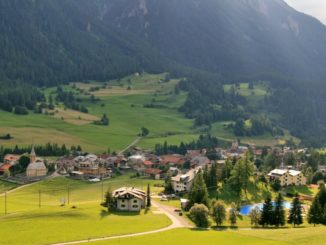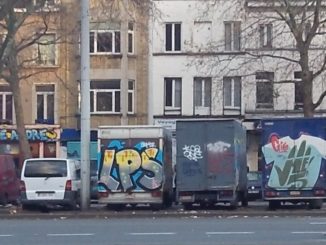
Okubo is Tokyo’s main Koreatown and one of the very few large immigrant enclaves in the entire country. It’s a downtown area around two very busy railway stations, a little world to itself where people of Korean ancestry lived, worked, shopped, dined and enjoyed themselves in the postwar decades. This was the only place in Tokyo where you saw Korean words and Korean names publically displayed on doors and windows, or heard the language on the street. For many years, it was disreputable, all the more so as it overlapped with a red-light district. Since the 2002 World Cup and the Korean Wave, however, Okubo has become hip, especially among young women attracted by stores selling merchandise connected with Korean pop-stars and TV dramas.
In the middle of the commercial area, halfway up a small office block, is the Arirang centre, which houses a small library, office and Korean cultural exhibitions. Few visit it, as it is hard to find and barely big enough to hold more than 12 people at a time anyway. But I had long found it a useful resource. When I go back to Tokyo, I often drop by this place, to ask what is new in the Korean community.
In the late 2000s, I remember a long chat with I had there with a Ms. Kim. It was clear that despite the thaw, fundamental issues remained unresolved. She told me that although ethnic Koreans in the Okubo area go by their real names (honmyou), as she did, they still need to use assumed Japanese names (tsuumei) to function outside the enclave.
“Most zainichi still use the tsuumei,” she said, “because most employers continue to discriminate against us.”
Applying for a job, she had herself been asked, “Ms Kim, why don’t you change your name to Ms Kaneda?” Both names are written in Chinese characters meaning “gold,” but the Korean pronunciation Kim was deemed unacceptable for employment in Japan. (A roughly parallel situation in Britain would be a Japanese-ancestry person called, say, Kazuo Ishiguro, whose surname means stone-black, being told by his employer to rename himself Blackstone to sound more English). She also described being rejected by an estate agent. “I was asked to present my ID card and then the real estate agent said, ‘Oh, you have a foreigner registration card. Sorry, we don’t deal with foreigners.’” (Being politely told to fuck off by Japanese estate agents has long been a rite of passage for many foreign residents of Japan; I remember one American who flipped and overturned a desk in an estate agency.) Ms. Kim, born and bred in Japan, native in Japanese and indistinguishable from other Japanese people, was told this to her face. She had also been barred from visiting a friend in a hospital because she used her real name on signing in.
Although the discrimination had declined somewhat, she said, for one community, the North Koreans in Japan, things had got considerably worse, after it emerged in the early 2000s that, in the 1970s, Pyongyang had kidnapped a number of Japanese citizens (and incidentally a far larger number of South Korean citizens). The story of the large North Korean minority in Japan’s zainichi community is too complex to deal with here; in one line, it exists mainly because many zainichi chose to take North Korean citizenship after the war, when Kim Il-sung had great prestige as a Korean patriot, communism still had some appeal and the North had not yet been left in the dust by the South.
My last visit to the Arirang centre had been in 2014, and on that occasion I was told that while housing discrimination remained a serious problem, major Japanese companies, whose annual reports were now peppered with twenty-first century buzzwords like “diversity” and “inclusion,” had been forced to dismantle some of the barriers to hiring non-Japanese. Things had improved since the 1970s, when Hitachi was involved in a famous court case because it withdrew an employment offer on finding out that a guy called Pak Chong Sok had applied for a company post under his assumed Japanese name instead of his real Korean one. This kind of thing was no longer thinkable.
“But we zainichi are still usually hired when there is a Korean angle to the work, not for jobs that pure Japanese can do,” the guy I talked to said. The main discrimination issue now was “heito supichi” (hate speech) and zainichi in offices being ostracised and abused by colleagues.
“Unions in Japan are not interested in minority rights,” he said. “There are some pretty words in the constitution, but it means nothing.”
In fact, Japan does not have any legislation formally outlawing racial discrimination. I asked him, doesn’t the South Korean government have anything to say about this?
“South Korea is not interested in the zainichi community,” he replied. “They view us as foreigners. We live in different worlds. They want us to assimilate and disappear completely, just as the Japanese do.”
All this must seem scarcely credible to a western reader in 2017, in the age of supposedly global “multiculturalism.” In a western country, there would have been student demonstrations, boycotts and civil-rights campaigns at such injustice. But the Japanese are not keen on mass political activism, preferring to shove social problems out of sight. Most do not sympathise with the Japanese-Koreans anyway, viewing activists as malcontents and at worst as subversive ingrates who have abused their privilege of being allowed to live on Japanese soil. Low-level unpleasantness from the far right (Japan has as real far right) is constant — embassy protests, speaker-trucks in the streets, nuisance calls and messing with girls’ elaborate traditional Korean dresses — though nearly always small enough in scale to avoid media attention. Despite the Korean Wave, the zainichi still have no real outlet for self-expression, apart from a small number of writers and chat-show commentators who have become the “face” of the community on the box.
On my last visit to the Arirang centre, two years ago, I did not talk to anyone. I just looked at some of the materials in the library. There was a feature on what happened after the 1923 Great Kanto Earthquake. This again is something almost nobody outside Japan has heard of. Of course, everybody knows about the earthquake, but for Koreans living in Tokyo, a second tragedy followed immediately on its heels. Some 8,000 of them were murdered by Japanese vigilante groups and others who accused them of looting, poisoning wells and otherwise exploiting the chaos. This incredible orgy of violence is a lasting stain on the Japanese character. What is still more incredible is that in the subsequent decades there has never been an official inquiry into what happened to Tokyo’s Koreans in 1923. Those responsible for the killings got off scot-free and the whole thing went down the memory hole. It is only known today because of the work of small groups of activists, whose reports can be read in places like the Arirang centre.
I look forward to Kazuo Ishiguro’s take on all these things.
© text & images Joe Slater 2017 2024



